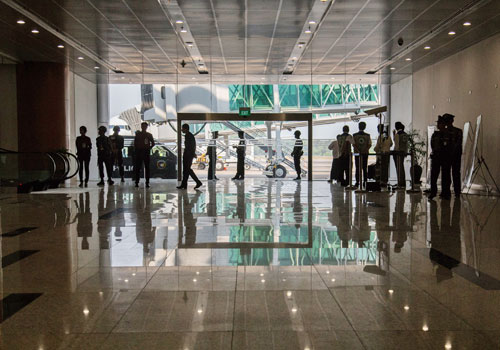As international airlines fight to add new Myanmar routes and destinations the country’s airspace is becoming increasingly crowded. With an eye on safety the Department of Civil Aviation (DCA) is looking at switching to a space-based surveillance system to keep track of the rising number of foreign and domestic aircraft in the skies.

Almost 30 international airlines now fly to Myanmar, and the number of weekly international flights from Yangon more than tripled between 2010 and 2015. A booming economy and visa-free agreements with neighbouring countries are helping prompt foreign carriers to eye new destinations and more frequent flights.
Monitoring and tracking all these aircraft falls to the DCA, which provides air traffic control, navigation and communications services for planes inside the country’s airspace.
In order to provide these services the DCA relies on ground-based surveillance technology like radar, but faces difficulties because much of Myanmar is remote and the terrain challenging, according to U Soe Paing, director of Air Navigation Safety at the DCA.
Myanmar’s telecommunications industry has also turned to satellite-based systems for the same reason.
Safety is a “top priority” for the DCA, U Soe Paing said, and so it is looking at switching to a satellite system provided by US firm Aireon, which that company plans to have up and running in 2018.
A key benefit of the satellite-based system will be in bringing real-time aircraft surveillance to areas – remote or over water – where traditional systems are impractical, according to a recent report from airline industry non-profit the Flight Safety Foundation.
The satellite system will also allow real-time monitoring, helping civil aviation authorities to more accurately track aircraft and respond to emergencies, the report said.
“The Aireon service will offer us increased safety and visibility that exceeds the capabilities of ground-based infrastructure,” U Soe Paing said.
The DCA has signed a memorandum of understanding with Aireon to investigate how the system would work in Myanmar and the potential benefits. Aireon already has similar agreements with civil aviation authorities in Singapore and India, the firm said. Aireon and its partners are still in the process of deploying satellites. The system will use receivers placed on a network of 66 Low Earth Orbit satellites – the Iridium NEXT constellation – provided by US telco Iridium Communications.
The last of these satellites is expected to be in place by the end of 2017, allowing Aireon to have its surveillance system in place and operational the following year.
The firm is developing the new system in partnership with air navigation service providers in other countries including Canada, Italy, Ireland and Denmark.
Source: The Myanmar Times